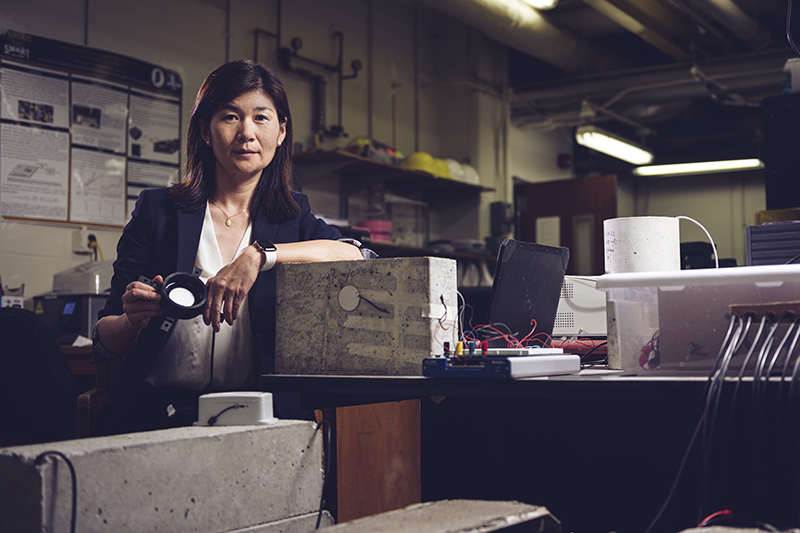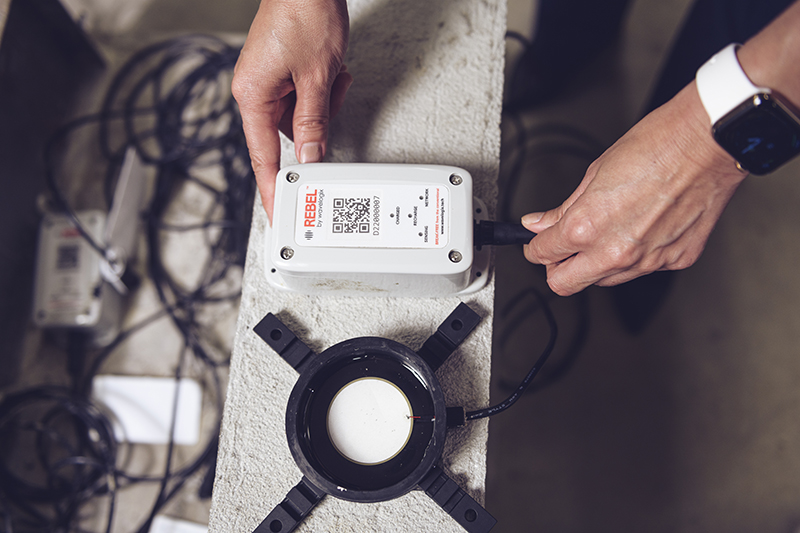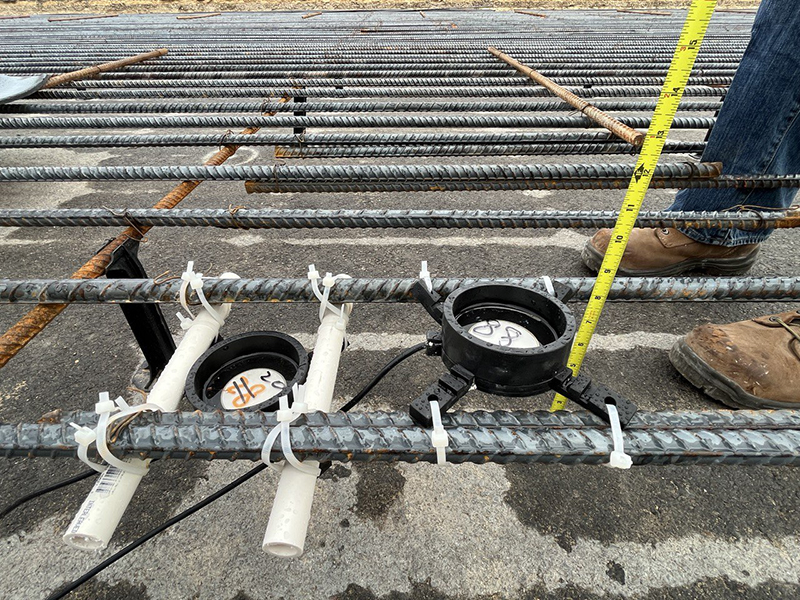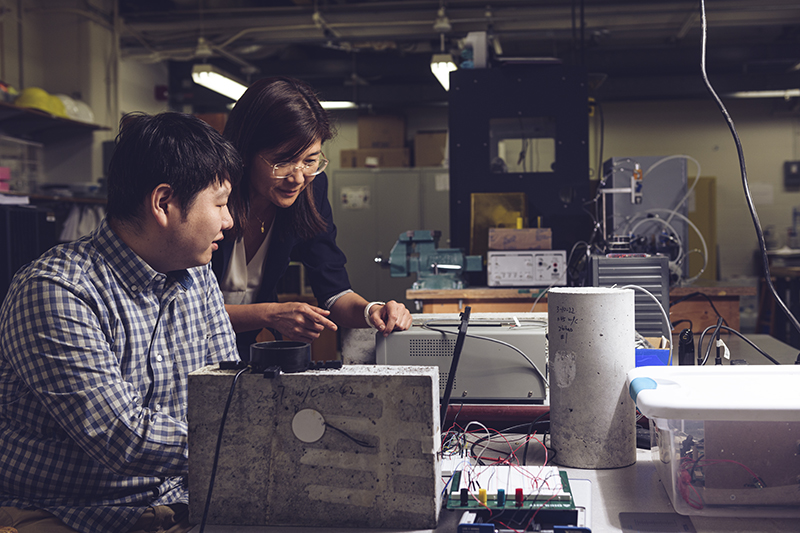March 13, 2023
‘Talking’ concrete could help prevent traffic jams and cut carbon emissions

Purdue University researcher Luna Lu has developed technology that could replace methods the construction industry has been using for more than a hundred years to test when concrete structures are ready to take on an external load. (Purdue University photo/Rebecca McElhoe)
Interstates throughout U.S. consider Purdue invention to reduce road repairs
WEST LAFAYETTE, Ind. – An increasing number of U.S. interstates are set to try out a Purdue University invention that could save millions of taxpayer dollars and significantly reduce traffic delays.
The invention, a sensor that allows concrete to “talk,” decreases construction time and how often concrete pavement needs repairs while also improving the road’s sustainability and cutting its carbon footprint.
Embedded directly into a concrete pour, the sensor sends engineers more precise and consistent data about the concrete’s strength and need for repair than is possible with currently used tools and methods.
“Traffic jams caused by infrastructure repairs have wasted 4 billion hours and 3 billion gallons of gas on a yearly basis. This is primarily due to insufficient knowledge and understanding of concrete’s strength levels,” said Luna Lu, the Reilly Professor and acting head of Purdue’s Lyles School of Civil Engineering, who has been leading development of the sensors since 2017. “For instance, we don’t know when concrete will reach the right strength needed to accommodate traffic loads just after construction. The concrete may go through premature failure, leading to frequent repairing.”
According to data from the Federal Highway Administration, concrete pavement makes up less than 2% of U.S. roads but approximately 20% of the U.S. interstate system. Lu’s research has focused on improving the conditions of concrete pavement first because it is the most challenging road material to repair. Concrete interstate pavement also must reliably support a large proportion of the nation’s traffic.
More than half of U.S. states with concrete interstate pavement have signed up to participate in a Federal Highway Administration pooled fund study to implement the sensors. The participating states are Indiana, Missouri, North Dakota, Kansas, California, Texas, Tennessee, Colorado and Utah.
Additional states are expected to join as the study kicks off in the coming months. Two states – Indiana and Texas – have already begun trying out the sensors in highway paving projects.
The technology also is on track to hit the market later this year as the REBEL Concrete Strength Sensing System, a product of WaveLogix. Lu founded WaveLogix in 2021 to manufacture the technology on a larger scale. The company licenses the technology from the Purdue Research Foundation Office of Technology Commercialization, which has applied for patent protection on the intellectual property.
Fast Company magazine named this invention one of its Next Big Things in Tech for 2022, which recognizes projects already making an impact on a real-world problem while also showing promise to make a greater impact in the years to come. The American Society of Civil Engineers’ 2021 Report Card for America’s Infrastructure also selected the technology as one of its “Gamechangers” for the year. Other organizations, such as the American Association of State Highway and Transportation Officials, have followed the technology’s developments since its initial introduction in 2019.
 From beneath a concrete pour, this black circular sensor transmits data about the concrete’s strength levels through a cord plugged into an above-ground handheld device called a data logger. Engineers receive real-time data from this device through a smartphone app. (Purdue University photo/Rebecca McElhoe)
Download image
From beneath a concrete pour, this black circular sensor transmits data about the concrete’s strength levels through a cord plugged into an above-ground handheld device called a data logger. Engineers receive real-time data from this device through a smartphone app. (Purdue University photo/Rebecca McElhoe)
Download image
Replacing century-old industry standards to make roads last longer
The Purdue invention is gradually rising as a better alternative to tests that have been the industry’s standard since the early 1900s.
Lu and her lab started developing the technology in 2017, when the Indiana Department of Transportation requested help in eliminating premature failure of newly repaired concrete pavement by more accurately determining when the pavement is ready to be opened to traffic.
After embedding an early prototype of the sensor into sections of various Indiana highways, INDOT added the sensor technology to its Indiana Test Methods Index. This index lists tests for contractors and construction workers to use to ensure road pavement quality.
Methods that the industry has used for more than a century call for testing large samples of concrete at a lab or onsite facility. Using that data, engineers estimate the strength level that a particular concrete mix will reach after it’s been poured and left to mature at a construction site. Even though these tests are well understood by the industry, discrepancies between lab and outdoor conditions can lead to inaccurate estimates of the concrete’s strength due to the different cement compositions and temperatures of the surrounding area.
With the technology Lu and her team invented, engineers no longer have to rely on concrete samples to estimate when fresh concrete is mature enough. Instead, they can directly monitor the fresh concrete and accurately measure many of its properties at once.
 Sensors developed by Luna Lu and her team are installed into the formwork of Interstate 35 in Texas. (Photo provided by Luna Lu)
Download image
Sensors developed by Luna Lu and her team are installed into the formwork of Interstate 35 in Texas. (Photo provided by Luna Lu)
Download image
The sensor communicates to engineers via a smartphone app exactly when the pavement is strong enough to handle heavy traffic. The stronger the pavement is before being used by vehicles, the less often it will need to be repaired. The ability to instantly receive information about the concrete’s strength levels also allows roads to open to traffic on time or sooner following a fresh pour.
Construction workers can install the sensors simply by tossing them onto the ground of the concrete formwork and covering them with concrete. Next, they plug the sensor cable into a reusable handheld device that automatically starts logging data. Using the app, workers can receive information on real-time changes in the concrete strength for as long as the strength data is required.
Cutting carbon emissions by cutting down on traffic and cement
By decreasing road repairs and construction timelines, this technology could reduce carbon dioxide that vehicles would have emitted while waiting in traffic to get around a construction site.
 Luna Lu’s lab is focused not just on making roads stronger and safer but also on helping the environment. (Purdue University photo/Rebecca McElhoe)
Download image
Luna Lu’s lab is focused not just on making roads stronger and safer but also on helping the environment. (Purdue University photo/Rebecca McElhoe)
Download image
Lu’s startup, WaveLogix, also is developing a way to curb carbon emissions by cutting the amount of cement needed in concrete mixes. The manufacturing of cement is responsible for 8% of the world’s carbon footprint. WaveLogix has made progress on a solution that uses artificial intelligence to optimize the design of concrete mixes based on data that the sensors would collect from highways across the country.
Construction codes call for a higher cement content in concrete mixes to ensure that concrete sample testing meets required strength thresholds. Excess cement can lead to premature cracks in pavement. Based on these code requirements and data from the Global Cement and Concrete Association, Lu estimates that concrete mix overdesign causes more than 1 billion tons of carbon emissions per year.
“The biggest problem with concrete mixes is that we use more cement to increase the concrete’s strength. That won’t help open the road to traffic any sooner,” Lu said.
These codes are based on how concrete mixes were made in the early 1900s, which was before equipment that could grind cement into finer powder was developed in the 1950s. Since concrete mixes use that finer powder today, they should have different water-cement ratios than a hundred years ago. The codes also don’t take into consideration how weather in different states impacts a concrete mix. A concrete pour in the middle of Indiana’s winter, for example, requires different concrete mixes to reach the right strength level than if the concrete were poured during California’s winter.
Lu believes that this new method using artificial intelligence could potentially reduce by 20% to 25% the amount of the cement used in concrete mixes – and simultaneously make pavement more durable and less expensive.
“I feel a strong sense of responsibility to make an impact on our infrastructure through developing new types of technology. In the field of civil engineering, if we don’t make an impact on the world, there won’t be a world to worry about,” Lu said.
About Purdue University
Purdue University is a top public research institution developing practical solutions to today’s toughest challenges. Ranked in each of the last five years as one of the 10 Most Innovative universities in the United States by U.S. News & World Report, Purdue delivers world-changing research and out-of-this-world discovery. Committed to hands-on and online, real-world learning, Purdue offers a transformative education to all. Committed to affordability and accessibility, Purdue has frozen tuition and most fees at 2012-13 levels, enabling more students than ever to graduate debt-free. See how Purdue never stops in the persistent pursuit of the next giant leap at https://stories.purdue.edu.
Writer/Media contact: Kayla Wiles, 765-494-2432, wiles5@purdue.edu
Source: Luna Lu, luna@purdue.edu
Note to journalists: Photos and video of Luna Lu’s concrete sensor research and b-roll of Purdue University’s campus are available via Google Drive. In addition, sound bites of Lu discussing her work and expertise are available to media who have an Associated Press subscription.

